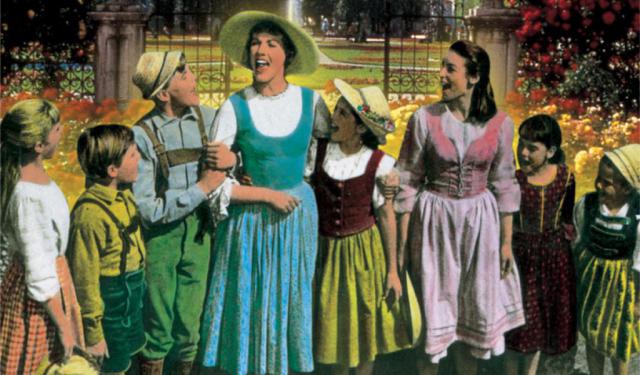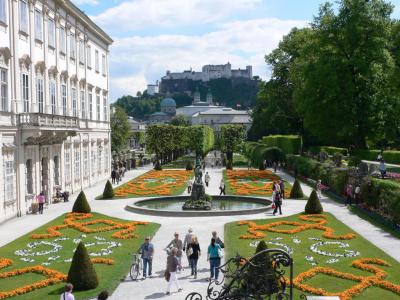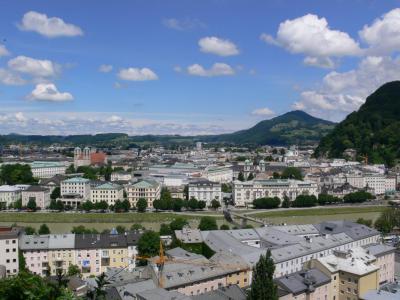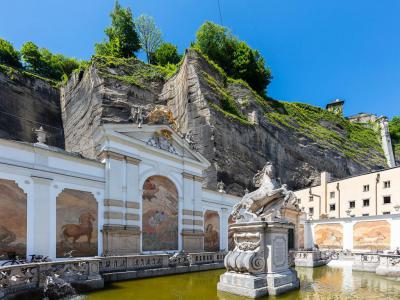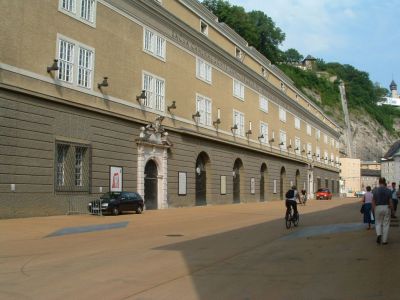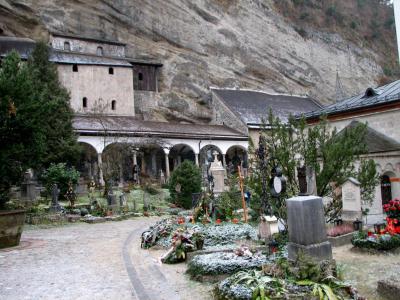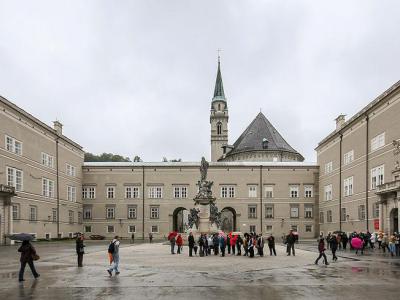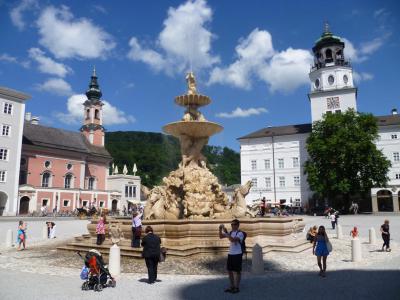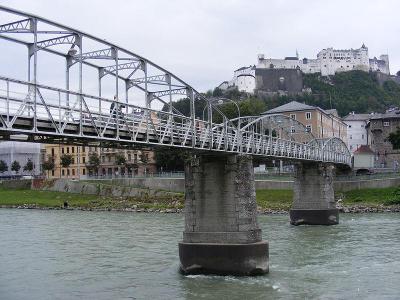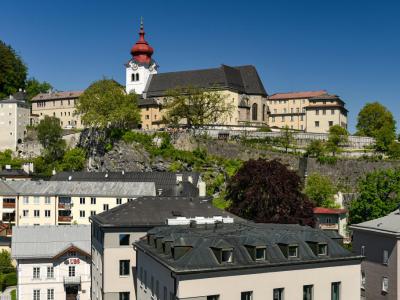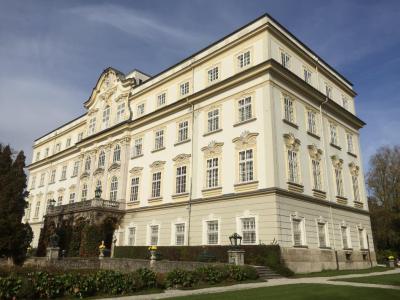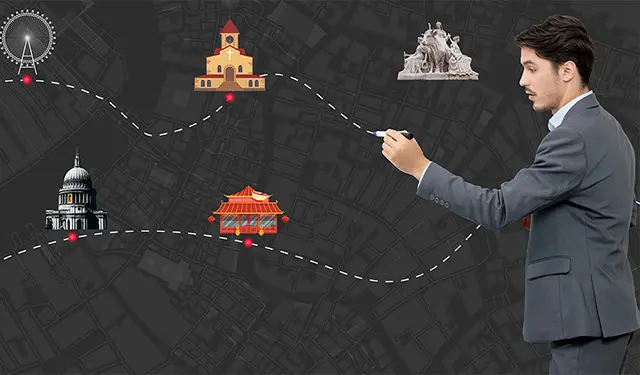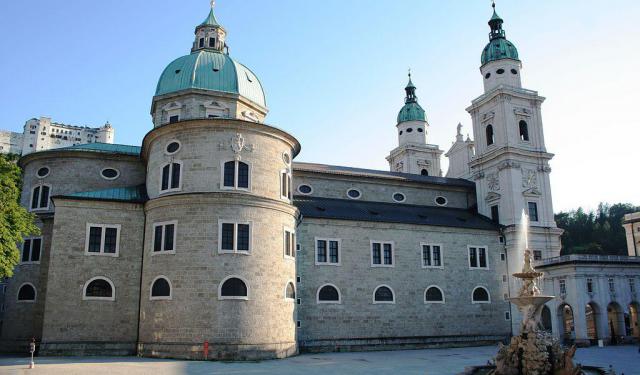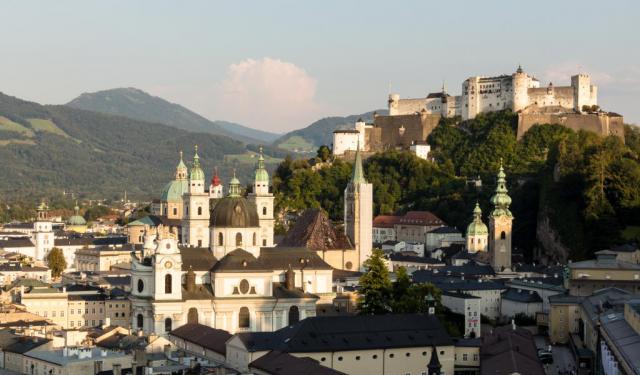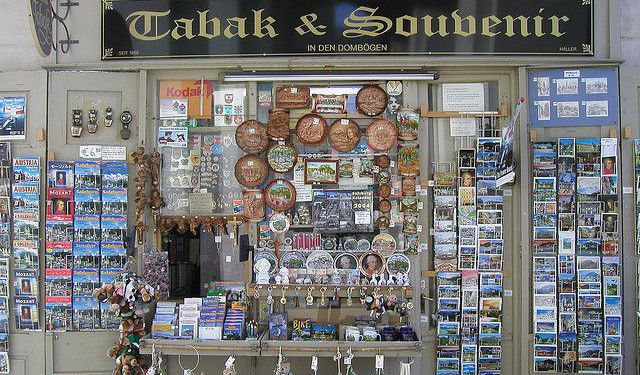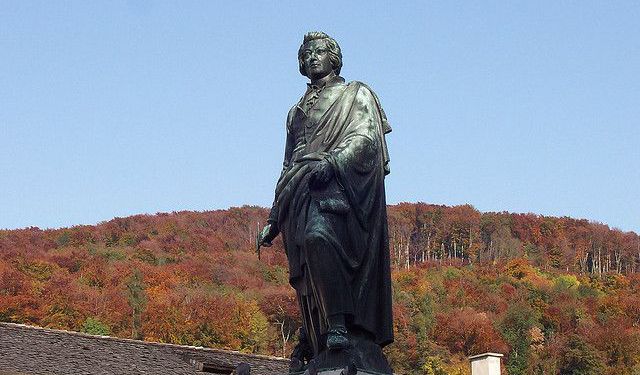Audio Guide: Sound of Music Tour (Self Guided), Salzburg
Salzburg-home of Mozart, marzipan, and musical nostalgia... While Wolfgang Amadeus gave the city its classical cred, it was The Sound of Music movie that turned Salzburg into a global stage, complete with singing nannies, dancing children, and enough picturesque scenery to make your Instagram weep with joy.
Shot in 1965, this Hollywood juggernaut followed the real-life story of Von Trapp family-and their very tuneful nanny Maria played by British actress Julie Andrews-on a journey of love, music, and dodging the Nazis. Set just before the Second World War, the film managed to wrap a heavy history lesson in a warm, melodic blanket. And more than half a century later, The Sound of Music’s echo still rings loud and clear through Salzburg’s Old Town.
If you’re a cinephile-or just like twirling dramatically in public parks-here’s your chance to step into the film’s most iconic spots.
We start at Mirabell Palace, where the “Do-Re-Mi” number begins high on Winkler Terrace before spiraling into a musical obstacle course through the palace gardens, fountains, and all.
Then there’s the Horse Bath Fountain, where the kids splash about singing “My Favorite Things.” Hydration and harmony...
Next stop: Salzburg Festival Halls. These historic halls hosted the Von Trapp kids’ big rehearsal, and later, the emotional “Edelweiss” and their bittersweet “So Long, Farewell.”
For a darker turn, head to Saint Peter’s Cemetery, whose ivy-covered tombstones doubled as the Von Trapps’ hiding spot. It's a peaceful place-unless you're being chased by the Gestapo, of course...
Domplatz and Residenzplatz both got screen time, too, during “I Have Confidence” and “My Favorite Things,” and you’ll also spot Mozart Bridge in that sequence. Yes, even the bridge had a cameo...
And the convent-that’s Nonnberg Abbey-is where the real Maria lived in the 1920s before she went from nun-in-training to singing stepmom.
Last but not least: Leopoldskron Castle, the elegant stand-in for the Von Trapp family home, especially all those dreamy lakeside scenes.
So, put on your walking shoes, warm up those vocal cords, and don’t forget your camera-because if you’re going to follow in the footsteps of The Sound of Music, you might as well make it a singalong.
Shot in 1965, this Hollywood juggernaut followed the real-life story of Von Trapp family-and their very tuneful nanny Maria played by British actress Julie Andrews-on a journey of love, music, and dodging the Nazis. Set just before the Second World War, the film managed to wrap a heavy history lesson in a warm, melodic blanket. And more than half a century later, The Sound of Music’s echo still rings loud and clear through Salzburg’s Old Town.
If you’re a cinephile-or just like twirling dramatically in public parks-here’s your chance to step into the film’s most iconic spots.
We start at Mirabell Palace, where the “Do-Re-Mi” number begins high on Winkler Terrace before spiraling into a musical obstacle course through the palace gardens, fountains, and all.
Then there’s the Horse Bath Fountain, where the kids splash about singing “My Favorite Things.” Hydration and harmony...
Next stop: Salzburg Festival Halls. These historic halls hosted the Von Trapp kids’ big rehearsal, and later, the emotional “Edelweiss” and their bittersweet “So Long, Farewell.”
For a darker turn, head to Saint Peter’s Cemetery, whose ivy-covered tombstones doubled as the Von Trapps’ hiding spot. It's a peaceful place-unless you're being chased by the Gestapo, of course...
Domplatz and Residenzplatz both got screen time, too, during “I Have Confidence” and “My Favorite Things,” and you’ll also spot Mozart Bridge in that sequence. Yes, even the bridge had a cameo...
And the convent-that’s Nonnberg Abbey-is where the real Maria lived in the 1920s before she went from nun-in-training to singing stepmom.
Last but not least: Leopoldskron Castle, the elegant stand-in for the Von Trapp family home, especially all those dreamy lakeside scenes.
So, put on your walking shoes, warm up those vocal cords, and don’t forget your camera-because if you’re going to follow in the footsteps of The Sound of Music, you might as well make it a singalong.
How it works: Download the app "GPSmyCity: Walks in 1K+ Cities" from Apple App Store or Google Play Store to your mobile phone or tablet. The app turns your mobile device into a personal tour guide and its built-in GPS navigation functions guide you from one tour stop to next. The app works offline, so no data plan is needed when traveling abroad.
Sound of Music Tour Map
Guide Name: Sound of Music Tour
Guide Location: Austria » Salzburg (See other walking tours in Salzburg)
Guide Type: Self-guided Walking Tour (Sightseeing)
# of Attractions: 10
Tour Duration: 2 Hour(s)
Travel Distance: 4.2 Km or 2.6 Miles
Author: julian
Sight(s) Featured in This Guide:
Guide Location: Austria » Salzburg (See other walking tours in Salzburg)
Guide Type: Self-guided Walking Tour (Sightseeing)
# of Attractions: 10
Tour Duration: 2 Hour(s)
Travel Distance: 4.2 Km or 2.6 Miles
Author: julian
Sight(s) Featured in This Guide:
- Mirabell Palace and Gardens
- Winkler Terrace
- Horse Bath (Pferdeschwemme)
- Salzburg Festival Halls Complex
- St. Peter's Abbey and Cemetery
- Domplatz
- Residenzplatz (Residence Square)
- Mozartsteg (Mozart Bridge)
- Nonnberg Convent
- Leopoldskron Castle
1) Mirabell Palace and Gardens (must see)
Mirabell Palace: part love story, part symphony, part surreal garden party. Here, Baroque drama meets soap opera realness and UNESCO-approved elegance. Originally constructed in 1606 by Prince-Archbishop Wolf Dietrich von Raitenau - who wasn’t just building a palace, but also a very fancy love nest for himself and his mistress - this place has always known how to turn heads.
After Wolf got the boot in 1612 (through palace intrigue), his successor renamed it Mirabell - meaning “wonderful” in Italian, which, come to think of it, is a bit more subtle than “Archbishop’s Love Shack.” The whole palace got a glitzy Baroque makeover between 1721 and 1727, and later a Neoclassical facelift - because palaces, of all properties, do need to keep up appearances...
Step inside and brace yourself for the grand staircase - or the 'staircase of thunder' if you like: with sweeping curves, angelic sculptures, and a shine so dramatic it practically sings. At the top of it is the Marble Hall. Mozart played here. You won’t. But you could get married here - if you book a few years ahead and maybe win a small lottery...
Fun fact: Hitler’s sister-in-law tied the knot here in 1944, with some disturbingly famous guests in attendance. But don’t let that kill the vibe - today, it’s more Mozart concerts and Instagram moments than fascist footnotes.
Venture further and you'll find a chapel dressed in Baroque finery, with statues so saintly they might just bless your photo.
Outside, the gardens are a mythological fever dream. Statues of Hercules, Aeneas, and Pluto look on, while the flower beds explode in geometric perfection - a riot of color that makes your eyeballs do pirouettes. At the center of it is the Pegasus Fountain, a scene-stealer from The Sound of Music’s “Do Re Mi.” Yes, that very one...
Climb the steps like a Von Trapp child chasing high notes, peek into the vine tunnel and hedge maze, and finish at Dwarf Park - where a regiment of lumpy marble gnomes stares you down with all the charm of a slightly haunted chess set.
And beyond it all, the High Salzburg Fortress, sitting smugly on its hilltop, watches centuries go by.
After Wolf got the boot in 1612 (through palace intrigue), his successor renamed it Mirabell - meaning “wonderful” in Italian, which, come to think of it, is a bit more subtle than “Archbishop’s Love Shack.” The whole palace got a glitzy Baroque makeover between 1721 and 1727, and later a Neoclassical facelift - because palaces, of all properties, do need to keep up appearances...
Step inside and brace yourself for the grand staircase - or the 'staircase of thunder' if you like: with sweeping curves, angelic sculptures, and a shine so dramatic it practically sings. At the top of it is the Marble Hall. Mozart played here. You won’t. But you could get married here - if you book a few years ahead and maybe win a small lottery...
Fun fact: Hitler’s sister-in-law tied the knot here in 1944, with some disturbingly famous guests in attendance. But don’t let that kill the vibe - today, it’s more Mozart concerts and Instagram moments than fascist footnotes.
Venture further and you'll find a chapel dressed in Baroque finery, with statues so saintly they might just bless your photo.
Outside, the gardens are a mythological fever dream. Statues of Hercules, Aeneas, and Pluto look on, while the flower beds explode in geometric perfection - a riot of color that makes your eyeballs do pirouettes. At the center of it is the Pegasus Fountain, a scene-stealer from The Sound of Music’s “Do Re Mi.” Yes, that very one...
Climb the steps like a Von Trapp child chasing high notes, peek into the vine tunnel and hedge maze, and finish at Dwarf Park - where a regiment of lumpy marble gnomes stares you down with all the charm of a slightly haunted chess set.
And beyond it all, the High Salzburg Fortress, sitting smugly on its hilltop, watches centuries go by.
2) Winkler Terrace
At Winkler Terrace, Salzburg spreads out beneath you like a perfectly arranged opera set, and all you’re missing is just a glass of good ol' Austrian-made Grüner Veltliner wine in hand. Perched on the southern edge of Monk's Hill, right above the sleek Museum of Modern Art, this terrace is where Baroque beauty meets modern minimalism… and where your camera roll goes to feel alive.
Back in the day, this spot was home to the swanky Hotel Winkler and its legendary café, so posh in fact, even the Alps probably felt underdressed. Demolished in the '90s, it made way for today’s M32 Café, where the view remains just as smugly spectacular and the coffee hopefully less overpriced.
And yes, film buffs, you’ve seen this view before. Maria and the Von Trapp kids hit a high note here in The Sound of Music, kicking off that toe-tapping “Do Re Mi” sequence before twirling their way down into town. It’s cinematic gold-and your Instagram doesn’t even need a filter.
Up here, Salzburg unfurls in style: domes, spires, the High Salzburg Fortress flexing on its hilltop throne, and if the skies behave, you’ll even catch the distant Alps doing their best background pose.
Regardless of whether you're climbing up like a noble mountain goat (15–20 minutes of cardio with a reward) or letting the Monk's Hill Lift whisk you up like the scenic VIP you are, Winkler Terrace delivers all the same. Quiet, photogenic, and smugly perfect at sunset-it’s Salzburg’s high point, literally and otherwise.
So, take a deep breath, sip your coffee, and bask in the moment. Maria had the right idea: the hills really are alive up here...
Back in the day, this spot was home to the swanky Hotel Winkler and its legendary café, so posh in fact, even the Alps probably felt underdressed. Demolished in the '90s, it made way for today’s M32 Café, where the view remains just as smugly spectacular and the coffee hopefully less overpriced.
And yes, film buffs, you’ve seen this view before. Maria and the Von Trapp kids hit a high note here in The Sound of Music, kicking off that toe-tapping “Do Re Mi” sequence before twirling their way down into town. It’s cinematic gold-and your Instagram doesn’t even need a filter.
Up here, Salzburg unfurls in style: domes, spires, the High Salzburg Fortress flexing on its hilltop throne, and if the skies behave, you’ll even catch the distant Alps doing their best background pose.
Regardless of whether you're climbing up like a noble mountain goat (15–20 minutes of cardio with a reward) or letting the Monk's Hill Lift whisk you up like the scenic VIP you are, Winkler Terrace delivers all the same. Quiet, photogenic, and smugly perfect at sunset-it’s Salzburg’s high point, literally and otherwise.
So, take a deep breath, sip your coffee, and bask in the moment. Maria had the right idea: the hills really are alive up here...
3) Horse Bath (Pferdeschwemme)
Tucked at the foot of Salzburg’s Monk’s Hill, in the city’s so-dramatic Festival District, stands what may be the world’s most flamboyant horsewash, the Horse Bath. Think of it as a 17th-century car wash, but for stallions, and with Baroque flair dialed up to eleven...
Commissioned in 1693 by Prince-Archbishop Johann Ernst von Thun - who clearly thought “washing horses” deserved the same pomp as a coronation - this stone spectacle wasn’t just for rinsing hooves. Oh no. It was a declaration: Salzburg could out-fabulous your water trough any day of the week.
Water flowed in via underground Roman-era canals, modernized in medieval times - because even plumbing, in Salzburg, has a legacy. And while there were other horse baths in the city, this one was the “Versailles” of horse tubs.
Front and center is a muscular rearing steed, held in check by its handler - a powerful marble moment sculpted by Michael Bernhard Mandl. Behind them - a technicolor riot of equine frescoes by Johann Michael Rottmayr, depicting horses in such over-the-top poses you'd think they were auditioning for an opera.
Today, the Horse Bath is a quiet gem, a stone’s throw from the Large Festival House (once the royal stables), offering a breather from Mozart-themed everything.
Film fans will also find it familiar, as the site made a brief cameo appearance in The Sound of Music. During the instrumental ending of “My Favorite Things,” Maria and the Von Trapp children pass by and splash around the fountain. Although some additional scenes filmed here didn’t make the final cut, the Horse Bath still holds a place in the movie’s visual memory.
In the end, it is both an architectural oddity and a historical gem, fully emblematic of Salzburg’s unique way of merging the everyday with the operatic. It's one part outdoor sculpture gallery, one part equine spa, and absolutely no part boring. A place where even sweaty horses got their moment in the spotlight...
Commissioned in 1693 by Prince-Archbishop Johann Ernst von Thun - who clearly thought “washing horses” deserved the same pomp as a coronation - this stone spectacle wasn’t just for rinsing hooves. Oh no. It was a declaration: Salzburg could out-fabulous your water trough any day of the week.
Water flowed in via underground Roman-era canals, modernized in medieval times - because even plumbing, in Salzburg, has a legacy. And while there were other horse baths in the city, this one was the “Versailles” of horse tubs.
Front and center is a muscular rearing steed, held in check by its handler - a powerful marble moment sculpted by Michael Bernhard Mandl. Behind them - a technicolor riot of equine frescoes by Johann Michael Rottmayr, depicting horses in such over-the-top poses you'd think they were auditioning for an opera.
Today, the Horse Bath is a quiet gem, a stone’s throw from the Large Festival House (once the royal stables), offering a breather from Mozart-themed everything.
Film fans will also find it familiar, as the site made a brief cameo appearance in The Sound of Music. During the instrumental ending of “My Favorite Things,” Maria and the Von Trapp children pass by and splash around the fountain. Although some additional scenes filmed here didn’t make the final cut, the Horse Bath still holds a place in the movie’s visual memory.
In the end, it is both an architectural oddity and a historical gem, fully emblematic of Salzburg’s unique way of merging the everyday with the operatic. It's one part outdoor sculpture gallery, one part equine spa, and absolutely no part boring. A place where even sweaty horses got their moment in the spotlight...
4) Salzburg Festival Halls Complex
The glitzy, dramatic heart of Salzburg - where horses once trotted - is now the place of triumph for tenors. The Salzburg Festival Complex, the festival’s main stage, comprises two sleek Festival Halls and the iconic Rock Riding School. The latter, believe it or not, started out in the 1600s as a very upscale venue for horseback prancing and the occasional animal hunt (just an average day out for the Prince Archbishops of Salzburg...).
Later, in 1926, Max Reinhardt – the Austrian-American theater director wizard – looked at this rocky riding arena and thought to himself, “This place needs drama!” And thus it began its second act as a cultural powerhouse.
Now, for the heavyweight: the Large Festival Hall – Salzburg’s answer to “go big or go home.” It was unveiled in 1960 with Richard Strauss’ The Knight of the Rose comic opera, conducted by none other than Herbert von Karajan himself. One of the greatest conductors of the 20th century, he didn’t just wave the baton there but also helped design the place (which is truly massive: carved right into Monk’s Hill, with a 100-meter-wide stage that could easily park a few airliners side by side). And just in case you forget you’re entering a temple of the arts, five bronze doors will remind you, crowned with a Latin motto saying: “The sacred house of the Muse is opened by a quick song / Here divine power brings us up with inspiration.”
Now, if you hear The Sound of Music jingle... don't be surprised. Remember that scene? The Rock Riding School, stretching dramatically against a cliff face, is where the Von Trapps belt out “Edelweiss,” win hearts, and then politely evade the Nazis mid-applause. Pure cinematic gold...
In real life, the Von Trapps did sing at the Festival – in 1935 and 1936 – and yes, they were brilliant (forming a choir of their own and winning first place). Only that was almost two years before the Nazi annexation of Austria. As for their dramatic exit (flight to Italy), it came in 1938 after they refused to serenade Hitler for his birthday. Bravo, indeed...
A backstage tour here isn’t just a walk through some old theater. No. It’s a peek into a world where art, architecture, and absurd ambition come together. You’ll stand under the Rock Riding School’s retractable roof and think: “Well, this escalated from pony lessons fast.”
Touring this place may last about an hour – but the stories you hear will stick with you much longer.
Later, in 1926, Max Reinhardt – the Austrian-American theater director wizard – looked at this rocky riding arena and thought to himself, “This place needs drama!” And thus it began its second act as a cultural powerhouse.
Now, for the heavyweight: the Large Festival Hall – Salzburg’s answer to “go big or go home.” It was unveiled in 1960 with Richard Strauss’ The Knight of the Rose comic opera, conducted by none other than Herbert von Karajan himself. One of the greatest conductors of the 20th century, he didn’t just wave the baton there but also helped design the place (which is truly massive: carved right into Monk’s Hill, with a 100-meter-wide stage that could easily park a few airliners side by side). And just in case you forget you’re entering a temple of the arts, five bronze doors will remind you, crowned with a Latin motto saying: “The sacred house of the Muse is opened by a quick song / Here divine power brings us up with inspiration.”
Now, if you hear The Sound of Music jingle... don't be surprised. Remember that scene? The Rock Riding School, stretching dramatically against a cliff face, is where the Von Trapps belt out “Edelweiss,” win hearts, and then politely evade the Nazis mid-applause. Pure cinematic gold...
In real life, the Von Trapps did sing at the Festival – in 1935 and 1936 – and yes, they were brilliant (forming a choir of their own and winning first place). Only that was almost two years before the Nazi annexation of Austria. As for their dramatic exit (flight to Italy), it came in 1938 after they refused to serenade Hitler for his birthday. Bravo, indeed...
A backstage tour here isn’t just a walk through some old theater. No. It’s a peek into a world where art, architecture, and absurd ambition come together. You’ll stand under the Rock Riding School’s retractable roof and think: “Well, this escalated from pony lessons fast.”
Touring this place may last about an hour – but the stories you hear will stick with you much longer.
5) St. Peter's Abbey and Cemetery (must see)
Saint Peter's Abbey (Stift Sankt Peter) is a Benedictine monastery and former cathedral. Considered one of the oldest monasteries in the German-speaking world, the abbey was founded in 696 by Saint Rupert. Despite challenges during the Nazi regime in 1938, the abbey maintained operation and remains active to this very day.
A marvelous steeple crowned with an onion dome gives an admirable facade to the Abbey Church. Since its dedication in 1147, this Romanesque church underwent multiple renovations, acquiring its Rococo style in 1782. The church houses significant graves, including that of Martin Luther's superior.
Saint Peter's Abbey is home to Austria's oldest library, comprising nearly 100,000 volumes. The Rococo-style library is particularly noted for its extensive collection of manuscripts, incunabula, and local history volumes, along with special collections of graphics and maps. It also contains a notable collection of music manuscripts from composers like Mozart and Haydn. Additionally, the abbey houses diverse collections of paintings and other artifacts, although some are not accessible to the public. Access to the library requires a special permit.
During his early years in Salzburg, Wolfgang Amadeus Mozart composed the Dominikus Mass for Saint Peter's Abbot Dominikus Hagenauer, in 1769. Hagenauer wrote in his diary: "Music for the Mass composed by Wolfgang Mozart, 14 years of age, was in every one's opinion most elegant. Wolfgang Mozart played on the great organ for half an hour to the astonishment of all." The composer returned to Saint Peter's in 1783 to conduct his "Mass in C minor," which is now performed at the Salzburg Festival each summer.
The abbey complex also contains a very old (established circa 700 AD) cemetery. The oldest graves in Saint Peter's Cemetery (Petersfriedhof) date back to the late 13th century. Distinguished individuals including Mozart's sister Nannerl (an accomplished musician in her own right), Joseph Haydn's brother Michael, and sculptor Josef Thorak are buried here.
The cemetery grounds are also known for the catacombs carved into rocks, which served as early Christian assembly places and hermitages. Wonderful to visit, they are filled with early altars, faded murals, and inscriptions.
In "The Sound of Music" movie, the Von Trapp family goes into hiding from the Nazis at a local cemetery. The actual scene was filmed on a Hollywood set meticulously recreating the setting inspired by Saint Peter's cemetery.
Why You Should Visit:
Everything here is free to visit except for the catacombs which cost a modest fee.
A marvelous steeple crowned with an onion dome gives an admirable facade to the Abbey Church. Since its dedication in 1147, this Romanesque church underwent multiple renovations, acquiring its Rococo style in 1782. The church houses significant graves, including that of Martin Luther's superior.
Saint Peter's Abbey is home to Austria's oldest library, comprising nearly 100,000 volumes. The Rococo-style library is particularly noted for its extensive collection of manuscripts, incunabula, and local history volumes, along with special collections of graphics and maps. It also contains a notable collection of music manuscripts from composers like Mozart and Haydn. Additionally, the abbey houses diverse collections of paintings and other artifacts, although some are not accessible to the public. Access to the library requires a special permit.
During his early years in Salzburg, Wolfgang Amadeus Mozart composed the Dominikus Mass for Saint Peter's Abbot Dominikus Hagenauer, in 1769. Hagenauer wrote in his diary: "Music for the Mass composed by Wolfgang Mozart, 14 years of age, was in every one's opinion most elegant. Wolfgang Mozart played on the great organ for half an hour to the astonishment of all." The composer returned to Saint Peter's in 1783 to conduct his "Mass in C minor," which is now performed at the Salzburg Festival each summer.
The abbey complex also contains a very old (established circa 700 AD) cemetery. The oldest graves in Saint Peter's Cemetery (Petersfriedhof) date back to the late 13th century. Distinguished individuals including Mozart's sister Nannerl (an accomplished musician in her own right), Joseph Haydn's brother Michael, and sculptor Josef Thorak are buried here.
The cemetery grounds are also known for the catacombs carved into rocks, which served as early Christian assembly places and hermitages. Wonderful to visit, they are filled with early altars, faded murals, and inscriptions.
In "The Sound of Music" movie, the Von Trapp family goes into hiding from the Nazis at a local cemetery. The actual scene was filmed on a Hollywood set meticulously recreating the setting inspired by Saint Peter's cemetery.
Why You Should Visit:
Everything here is free to visit except for the catacombs which cost a modest fee.
6) Domplatz
Wedged between Salzburg Cathedral and a cluster of church-owned buildings, Domplatz isn’t just a picturesque square-it is also the beating festive heart of the city. Every winter, for over 500 years (yes, five centuries of yuletide commitment), the square transforms into a Christmas market wonderland. Wooden huts sprout up like festive mushrooms, brimming with handmade trinkets, rustic crafts, and all things delicious like mulled wine warming your soul and chestnuts roasted to perfection.
If you find yourself here on Christmas Eve, prepare for the Turmblasen-a centuries-old musical tradition where brass players serenade the square with chorales from above, either from the church tower or steeple. It’s like a holiday soundtrack sent straight from heaven.
Architecturally speaking, the square is framed by three grand open arches-north, south, and west-linking the cathedral, the Salzburg Residence palace, and St. Peter’s Abbey into one impressively enclosed rectangle of piety and Baroque ambition. Domplatz stretches 101 meters long, 69 meters wide, and is surrounded by walls so tall (81 meters!) you’d swear they were trying to touch the divine.
At the center of it all stands the Immaculate Mary column, a baroque marvel sculpted in the 1760s. With marble clouds, iron angels, and a globe-worthy Virgin Mary enthroned on top, it’s not exactly subtle. The surrounding statues get theatrical, too-angels beam, wisdom goes “poof,” the devil throws a tantrum, and the Church celebrates like it's just won the Eurovision contest.
If you stand dead center in the rear arcade, from that spot you can see the Marian statue align perfectly with the cathedral façade’s own angles, as if wearing its rooftop crown. Divine optics, indeed...
Oh, and if you're on the Sound of Music trail, you’ll spot Domplatz when Maria sweeps out through the arches and again as she and the kids dash across the square during the “My Favorite Things” montage. Picnic clothes, twirls, and all that...
If you find yourself here on Christmas Eve, prepare for the Turmblasen-a centuries-old musical tradition where brass players serenade the square with chorales from above, either from the church tower or steeple. It’s like a holiday soundtrack sent straight from heaven.
Architecturally speaking, the square is framed by three grand open arches-north, south, and west-linking the cathedral, the Salzburg Residence palace, and St. Peter’s Abbey into one impressively enclosed rectangle of piety and Baroque ambition. Domplatz stretches 101 meters long, 69 meters wide, and is surrounded by walls so tall (81 meters!) you’d swear they were trying to touch the divine.
At the center of it all stands the Immaculate Mary column, a baroque marvel sculpted in the 1760s. With marble clouds, iron angels, and a globe-worthy Virgin Mary enthroned on top, it’s not exactly subtle. The surrounding statues get theatrical, too-angels beam, wisdom goes “poof,” the devil throws a tantrum, and the Church celebrates like it's just won the Eurovision contest.
If you stand dead center in the rear arcade, from that spot you can see the Marian statue align perfectly with the cathedral façade’s own angles, as if wearing its rooftop crown. Divine optics, indeed...
Oh, and if you're on the Sound of Music trail, you’ll spot Domplatz when Maria sweeps out through the arches and again as she and the kids dash across the square during the “My Favorite Things” montage. Picnic clothes, twirls, and all that...
7) Residenzplatz (Residence Square) (must see)
As Salzburg's center of government, the historic Residence Square (Residenzplatz) has long been at the heart of the city, set on the site of a former Roman Forum. Originally known as Main Square (Hauptplatz), it was renamed after the Old Residence (Alte Residenz) Palace, the former dwelling of the city's rulers – prince-archbishops – located to the west.
Flanking the square on the sides are several important buildings, such as the Salzburg Cathedral (to the south), and the New Residence (Neue Residenz) to the east, with its bell tower now housing the Salzburg Museum (to the west).
The square's construction began in 1587, as part of the grand project by Prince-Archbishop Wolf Dietrich von Raitenau to make Salzburg the new "Rome of the North." For that purpose, some of the surrounding medieval homes, as well as the cemetery (above the ancient Roman Forum) had to be leveled.
The square's focal point is the massive central 45-foot-tall Residence Fountain (Residenzbrunnen). Completed between 1656 and 1661 by Tommaso di Garona, it is as Italian as it can be (reportedly the largest and most beautiful Baroque fountain outside of Italy). Made from Untersberg limestone, its design features a Triton statue that propels water upwards – an over-the-top version of Bernini's famous Triton Fountain in Rome.
Notably, in the movie “The Sound Of Music”, the lead character Maria sings "I Have Confidence in Me" while crossing the square by bus on her way to the Trapp villa. She's also seen playfully splashing the fountain's spouting horses.
In the more recent past, Residence Square served as a venue for major rock concerts by the likes of Joe Cocker and Tina Turner. Presently, apart from being a historical site, it is also a vibrant cultural venue hosting various events, including an open-air cinema during summer, a fair in September, and a Christmas market during Advent.
In the 2010s, the square underwent a refurbishment which included the erection of a monument to mark the 80th anniversary of the Nazi book burning that took place here in 1938.
Tip:
Grab some lunch from the nearby bakeries or shops and sit on one of the benches near the fountain, enjoying the view.
Flanking the square on the sides are several important buildings, such as the Salzburg Cathedral (to the south), and the New Residence (Neue Residenz) to the east, with its bell tower now housing the Salzburg Museum (to the west).
The square's construction began in 1587, as part of the grand project by Prince-Archbishop Wolf Dietrich von Raitenau to make Salzburg the new "Rome of the North." For that purpose, some of the surrounding medieval homes, as well as the cemetery (above the ancient Roman Forum) had to be leveled.
The square's focal point is the massive central 45-foot-tall Residence Fountain (Residenzbrunnen). Completed between 1656 and 1661 by Tommaso di Garona, it is as Italian as it can be (reportedly the largest and most beautiful Baroque fountain outside of Italy). Made from Untersberg limestone, its design features a Triton statue that propels water upwards – an over-the-top version of Bernini's famous Triton Fountain in Rome.
Notably, in the movie “The Sound Of Music”, the lead character Maria sings "I Have Confidence in Me" while crossing the square by bus on her way to the Trapp villa. She's also seen playfully splashing the fountain's spouting horses.
In the more recent past, Residence Square served as a venue for major rock concerts by the likes of Joe Cocker and Tina Turner. Presently, apart from being a historical site, it is also a vibrant cultural venue hosting various events, including an open-air cinema during summer, a fair in September, and a Christmas market during Advent.
In the 2010s, the square underwent a refurbishment which included the erection of a monument to mark the 80th anniversary of the Nazi book burning that took place here in 1938.
Tip:
Grab some lunch from the nearby bakeries or shops and sit on one of the benches near the fountain, enjoying the view.
8) Mozartsteg (Mozart Bridge)
If you’ve ever dreamed of a quiet stroll through Salzburg with a pinch of history and just the right amount of cinematic flair, step onto the Mozart Bridge-a delicate little Art Nouveau footbridge stretching its iron limbs across the Salzach River like a catwalk model in steel...
Built in 1903 as a private toll bridge (yes, even bridges had side hustles back then), this beauty owes its existence to a café owner who simply wanted more foot traffic for his enterprise. Literally. The plan was simple yet clever: build a shortcut, lure the thirsty masses, get profit. And it worked (because nothing says "boost my latte sales" like constructing your own pedestrian bridge).
Crafted entirely of steel but with the grace of a ballerina, the bridge still oozes charm with its elegant curves and delicate latticework. Think of it as the architectural equivalent of Mozart in bridge form-refined, a little showy, and impossible to ignore.
Adding depth to its charm is the river gushing below- the Salzach. Once a superhighway for salt barges, it now carries only fresh water in that signature Alpine green. For nearly 2,000 years, vessels laden with “white gold” mined nearby floated downstream, fueling the city's prosperity, turning salt into gold-or at least into ornate fountains and lavish palaces...
In 1921, the city took over the property, waved goodbye to tolls, and gave the Mozart Bridge to the people. Since then, it’s become an Insta-famous, photogenic darling for tourists and a star of the Sound of Music pilgrimage trail. Yes, this is the very spot where Maria and the Von Trapp kids frolic riverside, high on life, and show tunes during the tail end of “My Favorite Things.”
These days, it’s a peaceful and less-crowded shortcut for pedestrians exploring Salzburg, perfect for those dodging crowds or chasing sunsets. It links the Old Town to the leafy slopes of Capuchin Mountain and the quieter stretches of the Salzach, where you can pause mid-bridge and soak up the Baroque skyline, with the High Salzburg Fortress brooding handsomely in the background.
So, whether you're chasing film trivia, a photogenic moment, or just an escape route with style, the Mozart Bridge is your elegant accomplice. It doesn’t just get you from A to B-it gives you a scene worth remembering. Just don’t forget to hum a few bars of "Raindrops on roses..." while crossing. It’s tradition.
Built in 1903 as a private toll bridge (yes, even bridges had side hustles back then), this beauty owes its existence to a café owner who simply wanted more foot traffic for his enterprise. Literally. The plan was simple yet clever: build a shortcut, lure the thirsty masses, get profit. And it worked (because nothing says "boost my latte sales" like constructing your own pedestrian bridge).
Crafted entirely of steel but with the grace of a ballerina, the bridge still oozes charm with its elegant curves and delicate latticework. Think of it as the architectural equivalent of Mozart in bridge form-refined, a little showy, and impossible to ignore.
Adding depth to its charm is the river gushing below- the Salzach. Once a superhighway for salt barges, it now carries only fresh water in that signature Alpine green. For nearly 2,000 years, vessels laden with “white gold” mined nearby floated downstream, fueling the city's prosperity, turning salt into gold-or at least into ornate fountains and lavish palaces...
In 1921, the city took over the property, waved goodbye to tolls, and gave the Mozart Bridge to the people. Since then, it’s become an Insta-famous, photogenic darling for tourists and a star of the Sound of Music pilgrimage trail. Yes, this is the very spot where Maria and the Von Trapp kids frolic riverside, high on life, and show tunes during the tail end of “My Favorite Things.”
These days, it’s a peaceful and less-crowded shortcut for pedestrians exploring Salzburg, perfect for those dodging crowds or chasing sunsets. It links the Old Town to the leafy slopes of Capuchin Mountain and the quieter stretches of the Salzach, where you can pause mid-bridge and soak up the Baroque skyline, with the High Salzburg Fortress brooding handsomely in the background.
So, whether you're chasing film trivia, a photogenic moment, or just an escape route with style, the Mozart Bridge is your elegant accomplice. It doesn’t just get you from A to B-it gives you a scene worth remembering. Just don’t forget to hum a few bars of "Raindrops on roses..." while crossing. It’s tradition.
9) Nonnberg Convent
If you’re chasing The Sound of Music dream through Salzburg, chances are you’ll end up at Nonnberg Convent – the real deal behind the singing nuns, runaway governess, and all those "how-do-you-solve-a-problem-like-Maria" moments. Set above the city like a silent guardian since around 712 (yes, that’s not a typo), this Benedictine abbey is officially the oldest of its kind in the entire German-speaking world. It was founded by Saint Erentrudis, niece of Saint Rupert (also known as the “Bishop of Worms”).
The convent’s got all the architectural mood you’d want: Gothic spires, serene cloisters, a pillar hall, a chapel or two (or three), and a kitchen court that, thankfully, doesn’t serve reality TV drama. The ambiance is utterly tranquil – like Gregorian-chant-in-Latin-at-dawn tranquil. Which, incidentally, still happens daily at 6:45 am.
Now, if you're humming Do-Re-Mi already, here's your trivia fix: the real Maria – Maria Augusta Kutschera – checked into this convent to try the nun life at the age of 19 in 1924. She didn’t quite take to it and two years later, left to tutor a sick child of widowed Captain Georg von Trapp. And the rest is musical history. They married in 1927 – she was 22, he was 47, and nobody sang “Age is just a number,” but they might as well have...
Filming fun fact: although The Sound of Music made this place iconic, most of the indoor shots were done in California – apparently nuns don’t like camera crews cluttering up the cloisters. Still, four key scenes were shot just outside the gates: Maria leaving, nuns gossiping musically, the kids visiting, and the Nazi car sabotage moment – an underrated act of holy mischief.
Today, the convent is home to just 14 nuns, down from 50 in the 1960s. But the history still hums through the stone in this serene time capsule...
Pro tip:
Bring a few 50-cent coins. The Convent Museum lets you light up hidden Roman frescoes from 1140 and a baroque altar that’s been standing since 1515. Gothic, Romanesque, and drama-free – just how Saint Erentrudis would've liked it.
The convent’s got all the architectural mood you’d want: Gothic spires, serene cloisters, a pillar hall, a chapel or two (or three), and a kitchen court that, thankfully, doesn’t serve reality TV drama. The ambiance is utterly tranquil – like Gregorian-chant-in-Latin-at-dawn tranquil. Which, incidentally, still happens daily at 6:45 am.
Now, if you're humming Do-Re-Mi already, here's your trivia fix: the real Maria – Maria Augusta Kutschera – checked into this convent to try the nun life at the age of 19 in 1924. She didn’t quite take to it and two years later, left to tutor a sick child of widowed Captain Georg von Trapp. And the rest is musical history. They married in 1927 – she was 22, he was 47, and nobody sang “Age is just a number,” but they might as well have...
Filming fun fact: although The Sound of Music made this place iconic, most of the indoor shots were done in California – apparently nuns don’t like camera crews cluttering up the cloisters. Still, four key scenes were shot just outside the gates: Maria leaving, nuns gossiping musically, the kids visiting, and the Nazi car sabotage moment – an underrated act of holy mischief.
Today, the convent is home to just 14 nuns, down from 50 in the 1960s. But the history still hums through the stone in this serene time capsule...
Pro tip:
Bring a few 50-cent coins. The Convent Museum lets you light up hidden Roman frescoes from 1140 and a baroque altar that’s been standing since 1515. Gothic, Romanesque, and drama-free – just how Saint Erentrudis would've liked it.
10) Leopoldskron Castle
If rococo mansions had LinkedIn profiles, this one would list its founding in the 1730s, courtesy of the ever-so-fancy Prince-Archbishop Count Leopold Anton Eleutherius von Firmian-because of course that’s his name... Perched right on the lake's edge and showing off with mountain views like it owns the place (which, technically, it did), this castle has serious postcard energy.
But there’s more to it... In the early 20th century, theater maestro Max Reinhardt decided this fairytale setting needed a festival, and thus the Salzburg Festival was born. High culture with a lakeside breeze...
You can still stroll around the manicured grounds pretending you're royalty-or better yet, stay overnight and borrow a bicycle from the on-site hotel. Pedal off like you’re escaping the pressures of nobility… or just trying to find good coffee in town.
Still, the real reason half the world comes here is The Sound of Music. Indeed, this castle played the Von Trapp residence in all the iconic outdoor scenes-yes. Captain Von Trapp hearing his children sing for the first time? Right here. Maria and the gang tumbling into the lake? Also here. And those stone horses striking dramatic poses in front of Untersberg Mountain? You nailed it.
And while the real-life Von Trapp Villa is about four miles away and never made the cut for Hollywood, this castle absolutely did it. It even hosted the original “16 Going on 17” gazebo-until fans got a little too eager and started climbing the gates. The gazebo has since relocated to Hellbrunn Palace Gardens for its own safety and yours.
As for the grand interiors-the sweeping staircase, the ballroom fit for spinning in chiffon-all those were reimagined in Hollywood at Fox Studios. Because sometimes even a real-life castle isn’t dramatic enough.
Still, every single angle here is Instagram gold. And if you need to cool off from all the film nostalgia, there’s a fabulous public water park-Freibad Leopoldskron-right across the way. Cannonball optional...
But there’s more to it... In the early 20th century, theater maestro Max Reinhardt decided this fairytale setting needed a festival, and thus the Salzburg Festival was born. High culture with a lakeside breeze...
You can still stroll around the manicured grounds pretending you're royalty-or better yet, stay overnight and borrow a bicycle from the on-site hotel. Pedal off like you’re escaping the pressures of nobility… or just trying to find good coffee in town.
Still, the real reason half the world comes here is The Sound of Music. Indeed, this castle played the Von Trapp residence in all the iconic outdoor scenes-yes. Captain Von Trapp hearing his children sing for the first time? Right here. Maria and the gang tumbling into the lake? Also here. And those stone horses striking dramatic poses in front of Untersberg Mountain? You nailed it.
And while the real-life Von Trapp Villa is about four miles away and never made the cut for Hollywood, this castle absolutely did it. It even hosted the original “16 Going on 17” gazebo-until fans got a little too eager and started climbing the gates. The gazebo has since relocated to Hellbrunn Palace Gardens for its own safety and yours.
As for the grand interiors-the sweeping staircase, the ballroom fit for spinning in chiffon-all those were reimagined in Hollywood at Fox Studios. Because sometimes even a real-life castle isn’t dramatic enough.
Still, every single angle here is Instagram gold. And if you need to cool off from all the film nostalgia, there’s a fabulous public water park-Freibad Leopoldskron-right across the way. Cannonball optional...
Walking Tours in Salzburg, Austria
Create Your Own Walk in Salzburg
Creating your own self-guided walk in Salzburg is easy and fun. Choose the city attractions that you want to see and a walk route map will be created just for you. You can even set your hotel as the start point of the walk.
Historical Religious Buildings Walking Tour
The historic center of Salzburg, a UNESCO World Heritage Site since 1996, is home to numerous landmarks, including religious sites. Collectively, these historical sanctuaries, from small churches to the impressive Baroque-style Salzburg Cathedral, bear witness to the city's fascinating past and contribute a great deal of charm to its alluring present.
The local Saint Peter's Abbey is... view more
Tour Duration: 1 Hour(s)
Travel Distance: 1.4 Km or 0.9 Miles
The local Saint Peter's Abbey is... view more
Tour Duration: 1 Hour(s)
Travel Distance: 1.4 Km or 0.9 Miles
Salzburg Introduction Walking Tour
Dubbed the "City of Mozart", the enchanting Austrian city of Salzburg has gone down in history primarily as the hometown of its greatest son, Wolfgang Amadeus Mozart. His birthplace on a busy shopping street called Grain Lane (Getreidegasse) is now a museum. Also popular is the Mozart Residence, a place where the 18th-century composer spent much of his early life.
Apart from Mozart,... view more
Tour Duration: 2 Hour(s)
Travel Distance: 2.8 Km or 1.7 Miles
Apart from Mozart,... view more
Tour Duration: 2 Hour(s)
Travel Distance: 2.8 Km or 1.7 Miles
Old Town Gift Shops
Specialty shops make up an integral part of tourist life in Salzburg. The picturesque Old Town of Salzburg boasts a delightful array of gift shops, all within a pleasant walking distance, offering a diverse range of souvenirs and local treasures. Let's take a stroll through some of the notable establishments in this historic area.
We start at Kirchtag, a quaint gift shop known for its... view more
Tour Duration: 1 Hour(s)
Travel Distance: 0.9 Km or 0.6 Miles
We start at Kirchtag, a quaint gift shop known for its... view more
Tour Duration: 1 Hour(s)
Travel Distance: 0.9 Km or 0.6 Miles
Mozart Walking Tour
Salzburg was Mozart's home throughout most of his short life. For those who wish to immerse themselves in the Mozart world, there are several locations in the city well worth exploring.
Born on Grain Street (Getreidegasse) and baptized in the nearby Cathedral, Mozart played his first big concert, at age 6, at the Residence Palace.
Later, he served as an organist for the Cathedral,... view more
Tour Duration: 2 Hour(s)
Travel Distance: 2.4 Km or 1.5 Miles
Born on Grain Street (Getreidegasse) and baptized in the nearby Cathedral, Mozart played his first big concert, at age 6, at the Residence Palace.
Later, he served as an organist for the Cathedral,... view more
Tour Duration: 2 Hour(s)
Travel Distance: 2.4 Km or 1.5 Miles
The Most Popular Cities
/ view all
